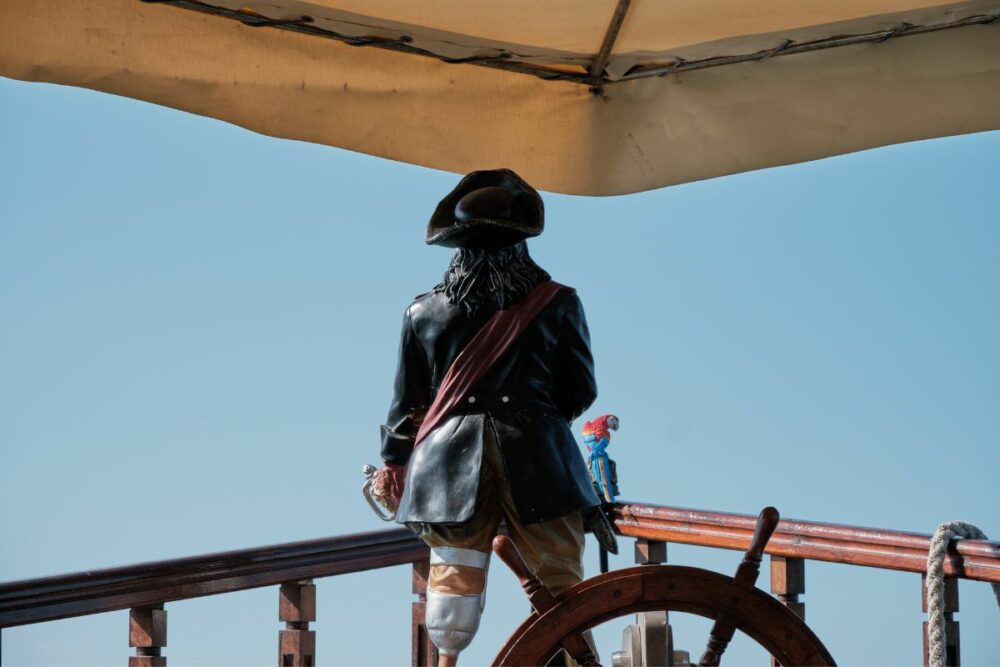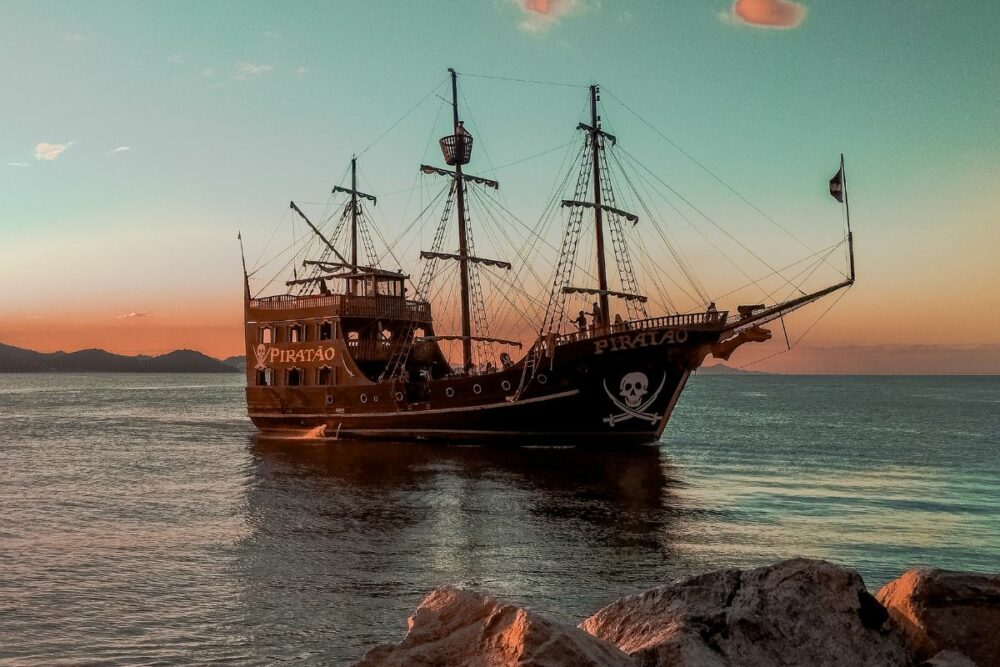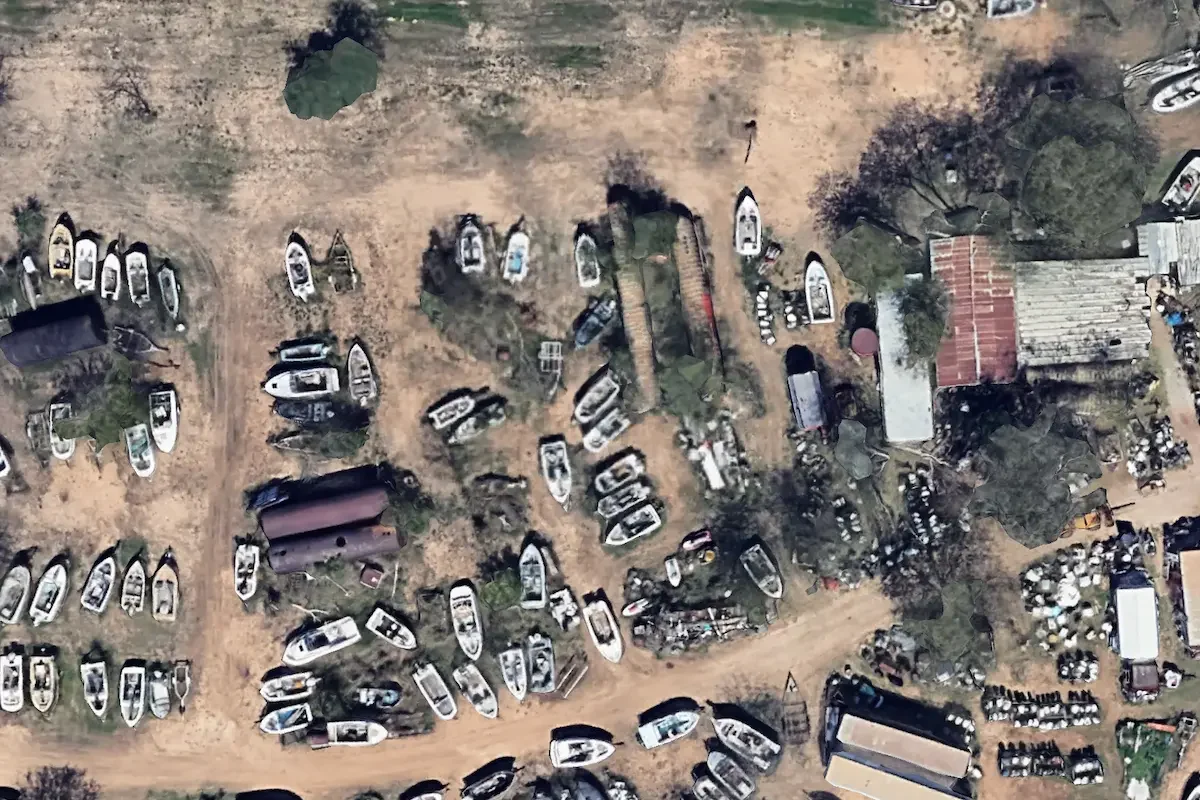I’m going to ask you to close your eyes for a second, conjure the image of a pirate in your brain, and then open them again. Okay, do it now. What did you see? I’m going to guess it was the image of a man with a dirty face and some facial hair.
He probably donned the typical captain’s hat, flowing clothes, and long boots. Did he have a hook for a hand? Did he fight with a sword in a way that looked light a choreographed dance? Was it your typical television pirate?

Maybe it was the kind that hunts down crocodiles and fights boys that never grow old. Perhaps it was the type that liked his rum and ran from Davie Jones. Either way, you probably regarded it the same way you would dinosaurs. Something that once was but is now long forgotten, never seen.
Do not be fooled. While they may not say shiver-me-timbers, down copious amounts of rum, or push people off planks, pirates are far from dead and buried.
Do Pirates Still Exist?
Yes, piracy still exists in the 21st century. The International Maritime Bureau (IMB) reports that piracy and armed robbery against ships are persistent issues. Modern pirates operate in various parts of the world, including the Gulf of Guinea, the waters off Somalia, the Malacca Straits, and the South China Sea. They employ sophisticated methods and equipment, making maritime security a significant concern.
Like everything else, they have simply adapted to suit the times we live in. And these modern pirates are still just as lethal, just as deadly, and just as destructive.
Pirates still exist in the modern world, although they have evolved and adapted to the times. They have traded swords for advanced weaponry like AK-47s and rocket launchers, making them more dangerous than ever.
They target ships, including cruise liners, and pirate attacks have actually increased in recent years, with piracy causing billions of dollars in losses annually. Notable areas for piracy include the Somali Coast, East Africa, the South China Sea, and certain South American coastlines. It is crucial to be aware of this ongoing threat and take measures to protect against it.
So, if you want to learn more about modern-day pirates, what they do, and where they’re lurking. Then jump aboard, as we sail through all the information there is to offer.
Sword Swapping
Long gone are the days when men with swords would take over a boat. Pirates have swapped out their old and outdated weaponry for far more advanced and technological equipment. The pirates that still lurk on the shores now have night-vision goggles and rocket launchers.
The modern-day pirates definitely still have one thing in common with their old and distant relatives. They continue to be heavily armed. As I say, they’ve moved over to much more advanced and destructive items, but they still have them nonetheless.
And if anything, their new equipment makes them only more dangerous and oh-so deadly.
While you’ve seen in movies that plenty of damage can be done from wielding a sword, it’s still not going to come close to matching the destruction they can do now through the use of AK-47s and other heavy machine guns.
With the use of night-vision goggles and rocket launchers, they don’t even need to come into close contact or engage in combat with ships anymore.
Hostages
While many things about Golden Age pirates and Modern-day pirates have changed, they still share a very similar goal. And that is to intimidate and maroon crew members on ships they deem bountiful.
You won’t tend to find many pirates that live their lives on the ocean waves anymore. More typically, they’ll live close to the shore and then attack via speedboats when they are ready to strike.
But when it comes to intimidation in their attacks, they still do not hold back. Many crew members of ships to this day are still taken hostage, often assaulted, and sometimes even killed by their captors.
Recent Developments in the Red Sea
In recent months, the Red Sea has emerged as a hotspot for maritime security concerns. Notable incidents, such as the attack on the container ship MSC UNITED VIII and the continuous targeting of merchant ships by Houthi forces, have underscored the vulnerability of this crucial maritime route. The attacks are part of a broader regional conflict, with ships associated with Israel being specifically targeted.
In response to the escalating threats, an international initiative, Operation Prosperity Guardian, has been established under the aegis of the Combined Maritime Forces.
This collaborative effort involves naval contributions from multiple countries and focuses on securing freedom of navigation, countering piracy, and preventing human trafficking and smuggling.
The substantial increase in shipping costs, a direct consequence of these security threats, has had far-reaching effects on global trade, reminiscent of the disruptions witnessed during the Covid-19 pandemic.
The situation in the Red Sea serves as a stark reminder of the intricate interplay between regional conflicts and global trade dynamics. As the international community grapples with these challenges, the need for a concerted and proactive approach to maritime security has never been more evident.
Crew and Ship Master Actions During a Pirate Attack: A Real-Life Example
A bulk carrier, while underway, encountered a severe threat when seven pirates aboard a skiff, launched from a mother vessel, aggressively approached. The pirates, armed with a machine gun and a rocket launcher, opened fire upon and successfully boarded the ship.
Situation Report: January 4, 2024, 13:14 UTC; Location: Approximately 455 nautical miles southeast of Eyl, Somalia (05:52N – 057:14E).
Immediate Response by the Ship Master and Crew:
- Alarm Activation: Upon detecting the pirate’s approach and subsequent boarding, the ship’s master immediately activated the vessel’s alarm system. This action served as an urgent call to action for the crew, signaling the start of emergency protocols.
- Contacting Local Authorities: Recognizing the gravity of the situation, the master wasted no time in contacting local maritime authorities to report the ongoing attack, ensuring that a distress signal was sent out to solicit immediate assistance.
- Activation of SSAS: The Ship Security Alert System (SSAS) was activated. This crucial step automatically notified designated contacts, including the ship’s company, flag state, and nearest coastal state, providing them with the ship’s location and the nature of the distress.
- Crew Muster in Citadel: Following the ship’s anti-piracy plan, all crew members quickly mustered in the citadel, a designated safe area designed to protect them from attackers. This action was pivotal in ensuring the crew’s safety, as it minimized their exposure to the pirates and potential harm.
Naval Intervention and Resolution:
The distress signals were promptly received by the Indian Navy, which responded decisively. An Indian navy warship in the vicinity dispatched a helicopter to locate the besieged vessel, followed by the warship’s arrival at the specified location.
A naval boarding team conducted a thorough search of the vessel to ensure no pirates remained on board and to assess the situation. Once the ship was declared clear of threats, and it was safe to do so, the crew was instructed to emerge from the citadel.
Outcome:
Thanks to the swift actions of the ship master, the disciplined response of the crew, and the timely intervention of the Indian Navy, control of the vessel was regained without any harm to the crew members. This incident underscores the importance of preparedness, the effectiveness of emergency protocols, and the critical role of international naval support in ensuring maritime safety.
Modern-Day Pirates Will Attack Cruise Ships

For those of you who enjoy a nice and leisurely cruise each and every year, you may want to stop reading now. I’m sorry if I’m about to spoil your relaxation time.
But pirates sometimes target cruise liners. As well as cargo vessels, private yachts, and any boat that promises them copious amounts of reward – also known as money.
They will follow their target with several boats and they will assault the ship with gunfire and grenades as well as any other damaging weaponry at their disposal. However, the good news is that cruise liners don’t tend to be their main target, and it doesn’t happen all that often.
However, it does still happen.
Pirate Attacks Are On The Rise
Yep, not only are pirates not at all extinct in the way that many would have you believe but actually, there has been an increase in the number of pirate attacks.
In fact, piracy over the last decade has risen by approximately 75%. It is estimated that there is a whopping 13-16 billion dollars lost internationally each year.
The number of pirate attacks peaked in 2010 and 2011 years when 445 and 421 pirate attacks were registered. A series of anti-piracy actions were performed by international forces and enforced patroling of some areas was started. Since 2010 a steady decrease in pirate attacks shows that main sea routes become safer.

Find more statistics at Statista
Where Pirate Attacks Are Most Common
Now, with all that has been said during this article, it is worth noting that there are many, many ships that will pass through international waters without seeing any sign of piracy.
There are parts of the planet where piracy is a thing of the past and has long been forgotten. Then there are the parts where piracy is rampant and a common issue.
The most notoriously known areas for piracy are around the Somali Coast. Particularly between the Red Sea and the Indian Ocean. You’ll also find that pirates are more commonly known as a threat in areas such as East Africa, the South China Sea, and some South American coastlines.
Final Thoughts
Pirates are often something we think of as almost fictional nowadays. We watch shows about them, we use them as a theme for kids’ birthday parties. We have long forgotten the terror and destruction that they can cause.
And no, you won’t find pirates who live out at sea, with gold teeth, hooks for hands, or wooden legs. But the pirates that you will see are far more deadly than any picture you can imagine.
The threat still very much lurks and waits. Except now, they travel through the water at much quicker speeds, their weaponry is far more perilous, and their intent is as sinister as it ever has been.
Modern-day pirates should not be forgotten about nor should they be underestimated. Many innocent people still suffer at the hands of such evil and more needs to be put in place to safeguard others.
Hopefully, awareness can be the first step in safeguarding. And now you know. Pirates do still very much exist. And they are still just as destructive.
- Wind-Assisted Propulsion Systems (WAPS): A Game Changer for Maritime Decarbonization – February 6, 2025
- 10 Boat Salvage Yards in California – January 25, 2025
- 13 Boat Salvage Yards in Texas – January 18, 2025




